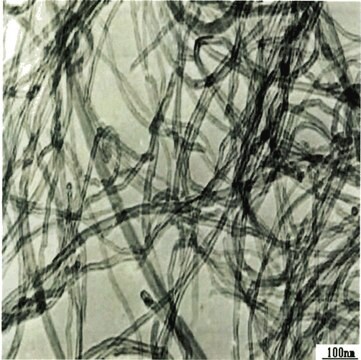406074
Carbon nanotube, multi-walled
powdered cylinder cores, 20-30% MWCNT basis, O.D. × L 7-12 nm × 0.5-10 μm, avg. no. of layers, 5 ‑ 20
Sinonimo/i:
MWCNT, MWNT, Multiwall carbon nanotube
About This Item
Prodotti consigliati
Livello qualitativo
Saggio
20-30% MWCNT basis
Stato
powder
Caratteristiche
avg. no. of layers 5 ‑ 20
Composizione
carbon content, >99% TGA
D.E. × lungh.
7-12 nm × 0.5-10 μm
Dimens. media delle particelle
−270 mesh
<53 μm
Punto di fusione
3652-3697 °C (lit.)
Densità
~2.1 g/mL at 25 °C (lit.)
Stringa SMILE
[C]
InChI
1S/C
OKTJSMMVPCPJKN-UHFFFAOYSA-N
Cerchi prodotti simili? Visita Guida al confronto tra prodotti
Categorie correlate
Descrizione generale
Applicazioni
Stato fisico
Nota sulla preparazione
Altre note
Codice della classe di stoccaggio
11 - Combustible Solids
Classe di pericolosità dell'acqua (WGK)
WGK 3
Punto d’infiammabilità (°F)
Not applicable
Punto d’infiammabilità (°C)
Not applicable
Dispositivi di protezione individuale
dust mask type N95 (US), Eyeshields, Gloves
Scegli una delle versioni più recenti:
Possiedi già questo prodotto?
I documenti relativi ai prodotti acquistati recentemente sono disponibili nell’Archivio dei documenti.
I clienti hanno visto anche
Articoli
Carbon nanotubes (CNTs) have received much attention since their discovery in 1991 by Sumio lijima1 due to their excellent mechanical, electrical, and optical properties.
A nanocomposite is typically defined as a mixture between a host material (e.g., polymer matrix) and nanofillers with at least one dimension of less than 100 nm.
Graphene is a one-atomic-layer thick two-dimensional material made of carbon atoms arranged in a honeycomb structure. Its fascinating electrical, optical, and mechanical properties ignited enormous interdisciplinary interest from the physics, chemistry, and materials science fields.
Single-walled carbon nanotubes (SWCNTs) are promising materials for use in the active channel of field-effect transistors (FETs), photoabsorbing layers of solar cells and photodetectors because of their ultrafast charge transport mobility.
Global Trade Item Number
| SKU | GTIN |
|---|---|
| 406074-25G | |
| 406074-500MG | 4061831987584 |
| 406074-5G | 4061833355398 |
| 406074-100MG | |
| 406074-1G | 4061831987577 |
| 406074-25MG |
Il team dei nostri ricercatori vanta grande esperienza in tutte le aree della ricerca quali Life Science, scienza dei materiali, sintesi chimica, cromatografia, discipline analitiche, ecc..
Contatta l'Assistenza Tecnica.




